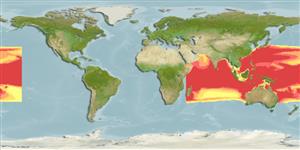>
Stomiiformes (Lightfishes and dragonfishes) >
Stomiidae (Barbeled dragonfishes) > Astronesthinae
Etymology: Astronesthes: Greek, astra = ray + Greek, esthes, -es = suit, something used to wrap (Ref. 45335).
More on author: Gilbert.
Environment: milieu / climate zone / depth range / distribution range
Ecologia
marino batipelagico; distribuzione batimetrica 25 - 704 m (Ref. 58302). Deep-water; 36°N - 33°S, 43°E - 154°W
Indo-Pacific: Japan, off the Hawaiian Islands, and the Timor Sea. Reported from Taiwan (Ref. 5193), Australia (Ref. 7300), and Yemen (Ref. 28061).
Size / Peso / Age
Maturity: Lm ? range ? - ? cm
Max length : 12.0 cm SL maschio/sesso non determinato; (Ref. 41299)
Spine dorsali (totale): 0; Raggi dorsali molli (totale): 11-13; Spine anali 0; Raggi anali molli: 17 - 20. AC discontinuous, 2 or 3 photopores ranging from 5th to 8th displaced upward. Barbel distinctly longer than head, its stem speckled with melanophores. A prominent black band extending from ventral to lateral side of caudal peduncle. Attains 12 cm SL.
Found on continental slopes and sea mountains (Ref. 41299). Benthopelagic (Ref. 58302).
Life cycle and mating behavior
Maturità | Riproduzione | Deposizione | Uova | Fecundity | Larve
Masuda, H., K. Amaoka, C. Araga, T. Uyeno and T. Yoshino, 1984. The fishes of the Japanese Archipelago. Vol. 1. Tokai University Press, Tokyo, Japan. 437 p. (text). (Ref. 559)
IUCN Red List Status (Ref. 130435)
Threat to humans
Harmless
Human uses
Informazioni ulteriori
BibliografiaAcquacolturaProfilo di acquacolturaVarietàGeneticaElectrophoresesEreditarietàMalattieElaborazioneNutrientsMass conversion
Strumenti
Special reports
Download XML
Fonti Internet
Estimates based on models
Preferred temperature (Ref.
123201): 11.7 - 23.4, mean 17.4 °C (based on 430 cells).
Phylogenetic diversity index (Ref.
82804): PD
50 = 0.5000 [Uniqueness, from 0.5 = low to 2.0 = high].
Bayesian length-weight: a=0.00417 (0.00171 - 0.01014), b=3.05 (2.83 - 3.27), in cm total length, based on LWR estimates for this (Sub)family-body shape (Ref.
93245).
Trophic level (Ref.
69278): 3.8 ±0.6 se; based on size and trophs of closest relatives
Resilienza (Ref.
120179): Alto, tempo minimo di raddoppiamento della popolazione meno di 15 mesi (Preliminary K or Fecundity.).
Fishing Vulnerability (Ref.
59153): Low vulnerability (10 of 100).
